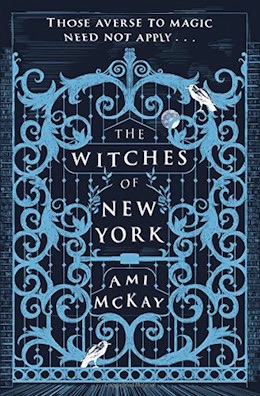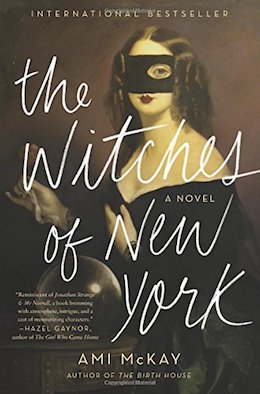Seventeen year old Beatrice Dunn has had it with her small town. She leaves her limited prospects in Stony Point for the wilds of New York City following a job notice in the newspaper for a “Respectable Lady” who is “well versed in sums, etiquette, tea making, and the language of flowers.” Beatrice is particularly keen on the last line of the advert: “Those averse to magic need not apply.” Tea and Sympathy is a magical tea shop catering to high society ladies run by a witch named Eleanor St. Clair and her fortune telling BFF Adelaide Thom. As Beatrice settles into her new digs, her magic flourishes beyond her wildest expectations and she learns to communicate with the dead.
Each of the women encounter a man that will change their lives. When Eleanor’s secret relationship with an engaged woman ends upon her marriage, the new husband seeks to punish Eleanor for her proclivities. Adelaide, having sworn to remain single, finds herself increasingly attached to a former army doctor who wants to use science to explain magic. Meanwhile, a reverend with a little too much time on his hands and an obsession with the Salem Witch Trials decides to “cure” Beatrice. On the edges lurk sinister supernatural forces with their sights set on the trio.
Think Practical Magic with Victorian twist and you’ll have a good sense for Ami McKay’s latest novel, The Witches of New York. Bookended between the arrival and display of Cleopatra’s Needle in Manhattan in 1880, this absorbing, amiable tale centers on three young witches and the violent men who seek to destroy them. Beatrice, Adelaide, and Eleanor take on the perils of an ancient evil and the vicious whims of the patriarchy all while brewing up spells and summoning spirits from beyond the veil. This is McKay’s second novel set in this world. The first, The Virgin Cure, features Moth, aka Adelaide, but Witches of New York isn’t a sequel and can be read as a standalone.
Overall, Witches of New York is a fine novel, but there are some troubling elements just under the surface. First off, I’m really tired of people tossing around “Gypsy” like it’s no big deal. While I get that the novel uses the terminology of the era, historical fiction has managed just fine with using non-offensive words to describe other groups. That word has long been established as a derogatory term for Rroma, so why are we still using it? This is the second ARC I’ve read this month with that slur. Seriously, writers and editors, y’all need to put an end to this. (Addendum: can we also stop giving every Rroma character dark, mystical powers? That stereotype has long since been played out.)
As much as Witches of New York is all about female empowerment and 19th century nasty women taking on the patriarchy, ultimately it’s indistinguishable from contemporary white feminism. Witches of New York is feminist only if you define feminism by how it assists white women. Eleanor, Beatrice, and Adelaide didn’t offer their witchy means of empowerment and self-determination to women like me.
By the 1880s, African American women were active in the women’s suffrage movement, especially the American Woman Suffrage Association, an abolitionist group that supported Black male suffrage. McKay, however, features the National Woman’s Suffrage Association group, an organization formed by Susan B. Anthony and Elizabeth Cady Stanton when they refused to back the 15th Amendment because it didn’t include women and caused a schism in the American Equal Rights Association. I don’t know why McKay chose to represent the NWSA over the AWSA, but it adds another layer of uncomfortableness to the larger social context in which the novel sits. Although the effect was likely unintentional, by excluding women of color, McKay perpetuates the myth that feminism is one-size-fits-all.
I also wasn’t too happy with how the queer romance is reduced to a man’s plot device. Eleanor never talks about her sexuality or what it means to be a lesbian in the Victorian period. For her, queerness seems to just be sexual dalliances with pretty young women rather being a part of her identity. Worse, when her lover disappears, she’s more or less forgotten about in lieu of giving page after page to her vengeful husband. When the only person in a novel to have an opinion about women being queer is the jealous husband, there’s a problem.
 Everything from the story to the characters to the narration was charming if a little twee. It felt almost like McKay was aiming for Jonathan Strange and Mr Norrell and missed. It’s not quite as fun as it could be, nor as deep as it thinks it is, but it’s a pleasant novel perfect for a picnic or the beach. The story is expansive, with a dozen or so characters all vying for attention.
Everything from the story to the characters to the narration was charming if a little twee. It felt almost like McKay was aiming for Jonathan Strange and Mr Norrell and missed. It’s not quite as fun as it could be, nor as deep as it thinks it is, but it’s a pleasant novel perfect for a picnic or the beach. The story is expansive, with a dozen or so characters all vying for attention.
To her credit, McKay does a good job giving them all unique personalities and enough depth to make them feel like they have interior lives beyond the plot. However, each character also has their own side plot, meaning there are a ton of loose threads to tie off at the end. So many loose threads that McKay drops a good chunk of them without any resolution or explanation. Whole characters seemingly very important early on vanish off the face of the earth without so much as a fare thee well. Same goes for the side plots: way too many of them, most abandoned without fanfare.
Yet McKay is good enough that the novel’s sprawling nature doesn’t come off as scattered or like she’s padding out a thin plot. It feels more like exploring a well-built world. I loved the little extras tacked on, like the newspaper clippings and the fairytale about the first witch and the demon, even though it is, again, very white and rich-focused and utterly ignorant of the actual history of cultural beliefs in magic. McKay piles on detail after detail to bring her magical New York to life. The attention to historical detail (save the demographics) is lush and exciting.
Her characters were a delight to read. I loved spending time with Eleanor, Adelaide, and Beatrice, and was rooting for them from page one. I longed to commiserate on the follies of men with Eleanor and a cuppa. I looked forward to Beatrice discovering the breadth and depth of her powers. And my heart ached with Adelaide’s as she blamed herself for what happened to Beatrice.
McKay is a powerful, beautiful writer, and her characters are fascinating and well-grounded. The novel was hard to put down. I was so hooked on what would happen next that I consumed all 500+ pages in just a few days. Even with the limited vision of feminism, absent diversity, and undercooked side plots, I still largely liked Witches of New York. If nothing else, Witches of New York was enough of an enticement to make me want to check out McKay’s other two books.
The Witches of New York is available from Harper Perennial.
Alex Brown is a teen librarian, writer, geeknerdloserweirdo, and all-around pop culture obsessive who watches entirely too much TV. Keep up with her every move on Twitter and Instagram, or get lost in the rabbit warren of ships and fandoms on her Tumblr.










